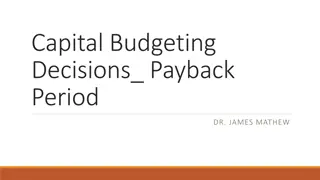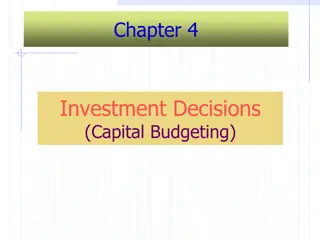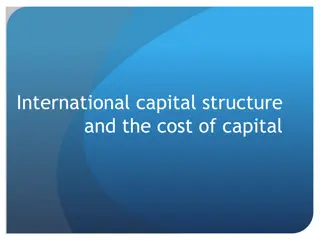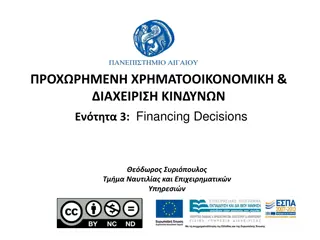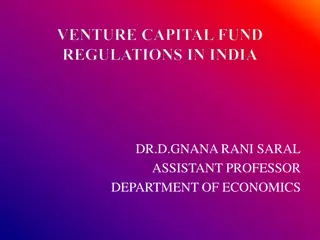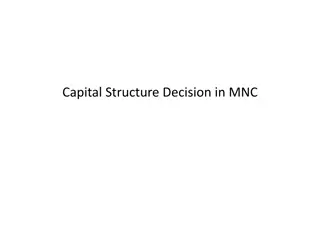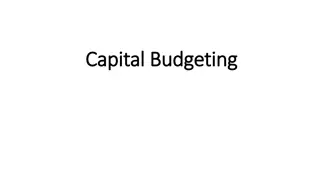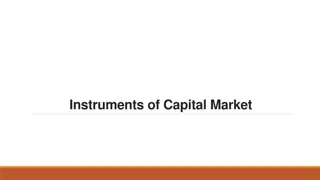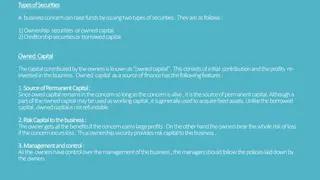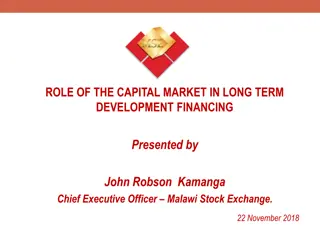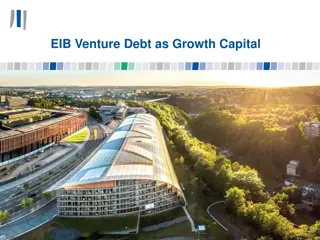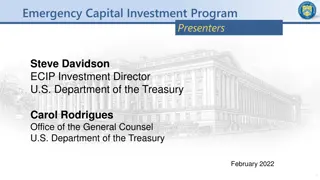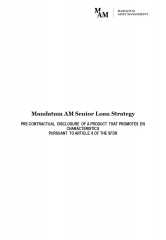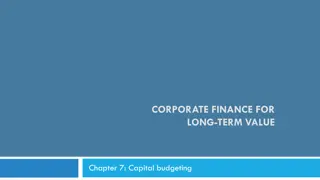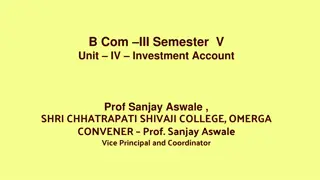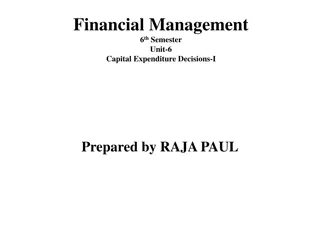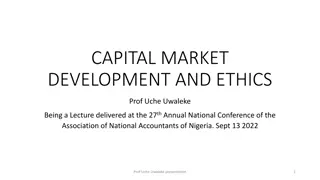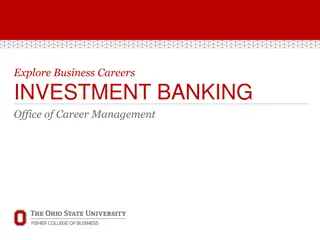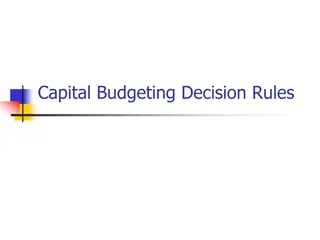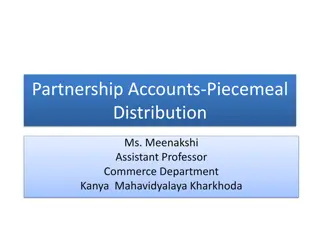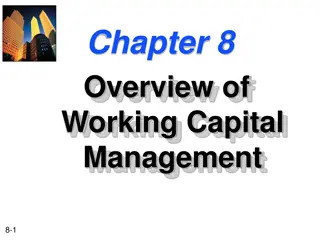Essential Considerations for Capital Investment Decisions
Making capital investment decisions involves evaluating relevant cash flows, considering sunk costs and opportunity costs, and assessing side effects. By focusing on incremental cash flows and excluding sunk costs, while considering opportunity costs and side effects, businesses can make informed decisions to maximize value creation.
Download Presentation

Please find below an Image/Link to download the presentation.
The content on the website is provided AS IS for your information and personal use only. It may not be sold, licensed, or shared on other websites without obtaining consent from the author. Download presentation by click this link. If you encounter any issues during the download, it is possible that the publisher has removed the file from their server.
E N D
Presentation Transcript
Chapter 6: Making capital investment decisions Corporate Finance
Outline I. Relevant/incremental cash flows II. An example III. The equivalent annual cost method
TVM We need to evaluate a new project using the TVM technique. That is, we should discount future expected cash flows (specifically, FCFs) back to present time and compare PV to initial costs: whether NPV > 0? Discount after-tax cash flows, not earnings.
Relevant cash flows But before we do this, a few notions about cash flows need to be addressed. The cash flows in the capital-budgeting time line need to be relevant cash flows; that is they need to be incremental in nature. Incremental cash flows: those cash flows that will only occur if the project is accepted.
Ask the right question You should always ask yourself Will this cash flow occur ONLY if we accept the project? If the answer is yes , it should be included in the analysis because it is incremental. If the answer is no , it should not be included in the analysis because it will occur anyway.
Sunk costs A sunk cost is a cost that has already occurred regardless of whether the project is accepted. Example: consulting fee for evaluating a project. Sunk costs should not be taken into consideration when evaluating a project.
Opportunity costs Opportunity costs (OCs) are the costs of giving up the second best use of resources. Example: a vacant land. Opportunity costs should be taken into consideration when evaluating the project.
Side effects Accepting a new project may have side effects. Erosion occurs when a new project reduces the sales and cash flows of existing projects. Synergy occurs when a new project increases the sales and cash flows of existing projects. Cash flows due to erosion and synergy are incremental cash flows.
A sample question You spent $500 last week fixing the transmission in your car. Now, the brakes are acting up (becoming troublesome) and you are trying to decide whether to fix them or trade the car in for a newer model. In analyzing the brake situation, the $500 you spent fixing the transmission is a(n) _____ cost. a. opportunity b. fixed c. incremental d. sunk e. relevant
A sample question The most valuable alternative that is given up if a particular investment is undertaken is called: a. Sunk cost. b. Opportunity cost. c. Dead-weight cost. d. Erosion cost. e. None of the above.
An example, I Baldwin Company is considering an investment project: producing colored bowling balls. The estimated life of the project: 5 years. The cost of test marketing: $250,000. Would be produced in a vacant building owned by the firm; the property can be sold for $150,000 after taxes. The cost of a new machine: $100,000. The estimated market value of the machine at the end of 5 years: $30,000.
An example, II Production by year for the 5-year life: 5,000 units, 8,000 units, 12,000 units, 10,000 units, and 6,000 units. The price of bowling balls in the first year: $20. The price of bowling balls will increase at 2% per year. No debt financing; no interest expenses (assumed throughout this chapter).
An example, III First-year production costs: $10 per unit. Production costs will increase at 10% per year. Incremental/marginal corporate tax rate: 34%. An initial investment (at year 0) in net working capital: $10,000. NWC at the end of each year will be equal to 10% of sales for that year. NWC at the end of the project is zero. NWC is NWC spending; i.e., change in NWC over one time period.
An example, IV Year 1 2 3 4 5 Units 5000 8000 12000 10000 6000 Price/unit 20 20.4 20.808 21.22416 21.648643 129891.9 Revenue 100000 163200 249696 212241.6 Cost/unit 10 11 12.1 13.31 14.641 Cost 50000 88000 145200 133100 87846
Depreciation Depreciation for tax purpose in the U.S. is based on the Modified Accelerated Cost Recovery System (MACRS). See Table 6.3 (p. 174) for IRS depreciation schedule. For a 5-year depreciation, the depreciation schedule is: 20% (year 1), 32% (year 2), 19.2% (year 3), 11.5% (year 4), 11.5% (year 5), and 5.8% (year 6).
An example, V Year 1 100000 50000 20000 Year 2 163200 88000 32000 43200 14688 28512 60512 16320 Year 3 249696 212241.6 129891.9 145200 133100 19200 11500 85296 67641.6 29001 22998.14 10385.59 56295 44643.46 20160.27 75495 56143.46 31660.27 24970 21224.16 Year 4 Year 5 Sales Costs Dep. 87846 11500 30545.86 Income before tax 30000 Tax Net Income OCF NWC 10200 19800 39800 10000
After-tax salvage cash flow OCF = sales costs taxes. The estimated salvage market value of the machine is 30% of $100,000; that is, $30,000. The machine will have been depreciated to 5.8% of $100,000 at that time; that is, $5,800. The taxable amount is $24,200 ($30,000 - $5,800). The after-tax salvage cash flow is: $30,000 (34% $24,200) = $21,772.
An example, VI Year 0 Year 1 Year 2 39800 Year 3 Year 4 Year 5 75495 56143 OCF Capital OC NWC NWC Salvage Total CF IRR 60512 31660 -100000 -150000 10000 -10000 150000 10000 16320 -6320 24970 21224 -8650 0 3745 21224 21772 -260000 16% 39800 54192 66846 59889 224656
Decision If the nominal discount rate (cost of equity) is less than 16%, we accept the project. In other words, if the discount rate is higher than 16%, we have a negative NPV.
NPV The firm uses no debt. Thus the appropriate discount rate is the cost of equity. Suppose that cost of equity is 15% (using the CAPM). NPV = 5473.43 (> 0).
An example, VII Year 0 Year 1 Year 2 39800 Year 3 Year 4 Year 5 75495 56143 31660.3 OCF Capital OC NWC NWC Salvage Total CF Re NPV 60512 -100000 -150000 10000 -10000 150000 10000 16320 -6320 24970 21224 -8650 0 3745 21224.2 21772 224656 -260000 15% 5473.43 39800 54192 66846 59889
Alternative definitions of OCF In our previous calculation, we used the top-down approach to compute OCF ( = sales costs taxes). Another 2 alternative methods: the bottom-up method, and the tax shield method. See pp. 180-181.
[Extra] Capital budgeting with the use of debt In the previous example, Baldwin Company does not use debt, thus the appropriate discount rate is the cost of equity. What if a project is evaluated by a firm that uses debt? The appropriate discount rate can be the WACC. P. 412, CH13: Suppose a firm is considering taking on a warehouse renovation costing $60 million. The project is expected to yield after-tax cost savings of $12 million a year for 6 years. The WACC for the firm is 7.78%. What is the NPV? NPV = -60 + 12/(1+7.78%) + 12/(1+7.78%)^2 + +12/(1+7.78%)^6 = -4.15 So reject it!
The equivalent annual cost method This method is useful (1) when one tries to choose between 2 machines of unequal lives, or (2) whether one should replace an existing machine with a new one. Whereas a general capital budgeting problem is often computed in nominal terms, the equivalent annual cost (EAC) method works best in real terms.
Nominal vs. real Time Nominal CF Expected Inflation Real CF 0 1 2 -1000 5% -1000 600 650 571.43 589.57
2 machines with unequal lives Revenues per year are the same, regardless of machine. The nominal discount rate (NR) is 13.3%. The expected inflation rate (E(I)) is 3%. The real discount rate (RR) is 10%. (1 + NR) = (1 + RR) (1 + E(I)) (1 + 13.3%) = (1 + 10%) (1 + 3%).
Real cost outflows w/ real discount rate Time 0 Time 1 Time 2 Time 3 Time 4 500 120 600 100 10% 798.42 916.99 Machine A Machine B Discount PV_A PV_B 120 100 120 100 100
Equivalent annual cost One needs to use real (nominal) discount rate to discount real (nominal) cash flows. For A, the EAC is $321.05. 798.42 PV; 3 N; 10 I/Y; CPT PMT. For B, the EAC is $289.28. 916.99 PV; 4 N; 10 I/Y; CPT PMT. B has a lower equivalent annual cost. We should choose B.
End-of-chapter Concept questions: 1-12. Questions and problems: 1-5 and 7-9 (or 7- 14 if EAC is taught).






